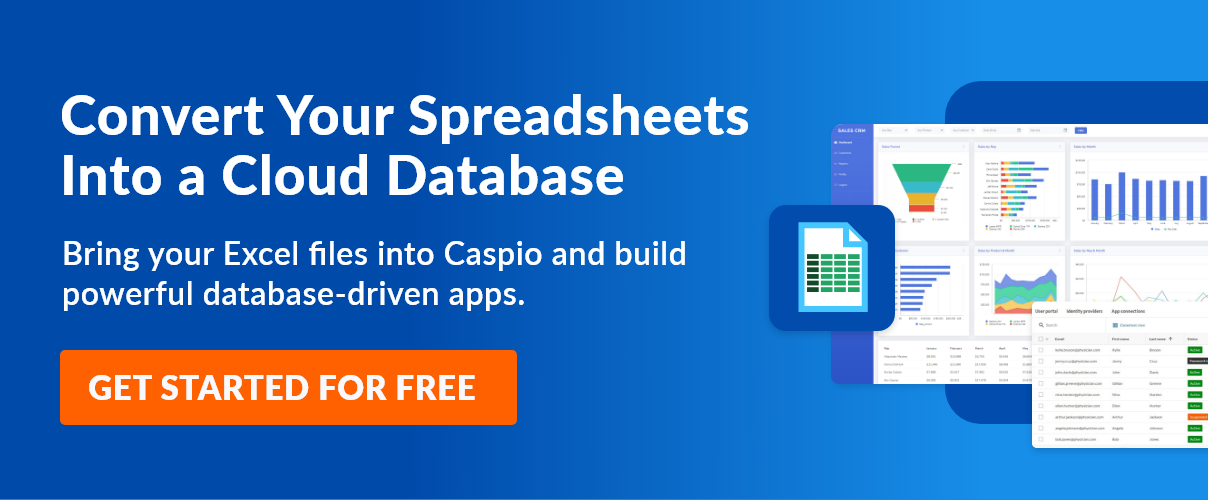5 of the Most Terrifying Excel Spreadsheet Horror Stories We’ve Ever Heard
August 15, 2018

More than 30 years after its initial release, Excel remains a force to be reckoned with. To this day, all kinds of organizations use the spreadsheet software to generate reports and analyze data.
However, unless you’re a data scientist or a spreadsheet junkie, combing through countless columns and rows of data can be extremely stressful. Although Excel is undeniably useful, it isn’t perfect for departments that have very specific needs. In fact, there have been numerous spreadsheet errors have caused scenes straight out of a horror movie.
So, turn that Excel spreadsheet into a powerful web app before it’s too late!
Meanwhile, here are five of the most terrifying Excel spreadsheet stories we’ve ever heard.
1. JPMorgan Chase’s Copy-and-Paste Error
What happened to JPMorgan Chase is a prime example how simple encoding errors can be costly for an organization. The financial giant suffered a trading loss of around $6.5 billion in May 2012 due to a copy-and-paste user error.
The lender was using Excel to create value-at-risk models, and a finance employee made the mistake of copying and pasting the wrong information from one spreadsheet to another. The formulas within the copied cells were not adjusted accordingly, resulting in gross miscalculations of their synthetic credit portfolio.
No other employee reviewed the data and tested the calculations to make sure they were accurate. What should have been an easily rectifiable spreadsheet error turned into the biggest financial loss that the JPMorgan Chase has ever taken.
2. Eastman Kodak’s Excess Zero Gaffe
In 2005, Eastman Kodak—or simply Kodak—was required to restate two quarters worth of financial records. An employee added too many zeroes to the pension and other employment termination benefit records of one other employee. When calculations on the spreadsheet were made, they resulted in an overstatement of $11 million in severance payments.
When talking about the erroneous data entry, Robert Brust, Kodak’s Chief Financial Officer and Executive Vice President, said: “The error itself involves an incorrect calculation of a severance accrual for one employee, the only such error out of approximately 6,000 employee reductions made this year.”
The company’s stock fell significantly when the error was made public. To add insult to injury, this happened during a time when the company was already losing more than $100 million every quarter.
3. Fannie Mae’s 1.3 Billion-Dollar Misstep
After reporting their third-quarter earnings in October 2003, the US Federal National Mortgage Association (popularly known as Fannie Mae) had to correct their financials due to a $1.136 billion discrepancy in their total shareholder equity.
In a written statement, Fannie Mae Senior Vice President Jayne Shontell described the error as an “honest” mistake. “There were honest mistakes made in a spreadsheet used in the implementation of a new accounting standard.”
4. Fidelity Investment’s Minus Symbol Blunder
In 1994, Fidelity Investments estimated they would make a $4.32 per share dividend distribution on their Magellan fund by the end of the year and promised to pay their shareholders accordingly. In January of 1995 though, the financial institution was forced to cancel the said dividend distribution after discovering that their estimation was incorrect. Massively incorrect.
How did this happen? An employee simply forgot to put in a minus sign.
While transferring financial records onto an Excel spreadsheet, a tax accountant neglected to put a minus sign on the fund’s net capital loss of $1.3 billion. The loss was then calculated as a net capital gain, which resulted in dividend estimates being off by a staggering $2.6 billion.
5. Emerson’s Missed Cell Formula Mix-up
Emerson Electric Co. is one of the biggest technology and engineering corporations in the world, with more than 100,000 employees and 250 manufacturing locations across the globe. That being said, even Fortune 500 companies are not immune to clerical mishaps involving spreadsheets.
Emerson incorrectly estimated the total cost of one contract bid. They came up short by $3.7 million all because of a single spreadsheet cell. The cell that contained the cost of electrical was not included in the formula that calculated total expenses. One cell missed, millions of dollars lost.
Build Your Custom App for a Happy Ending
These stories prove that a one-size-fits-all solution, coupled with human error, can lead to catastrophic losses even for the biggest companies in the world.
Increasingly, businesses require sophisticated search queries and data sequences, secure online access for multiple users, and dependable scalability. Today’s organizations need secure cloud applications that are customized to their exact needs.
So, don’t be the next Excel spreadsheet horror story!
The good news is that low-code platforms like Caspio allow business professionals to build secure and scalable custom online database applications without writing a single line of code. Now that’s a happy ending.
Want to know how it works? Get started on turning your Excel spreadsheets into a sophisticated database application. Schedule a free demo today!















